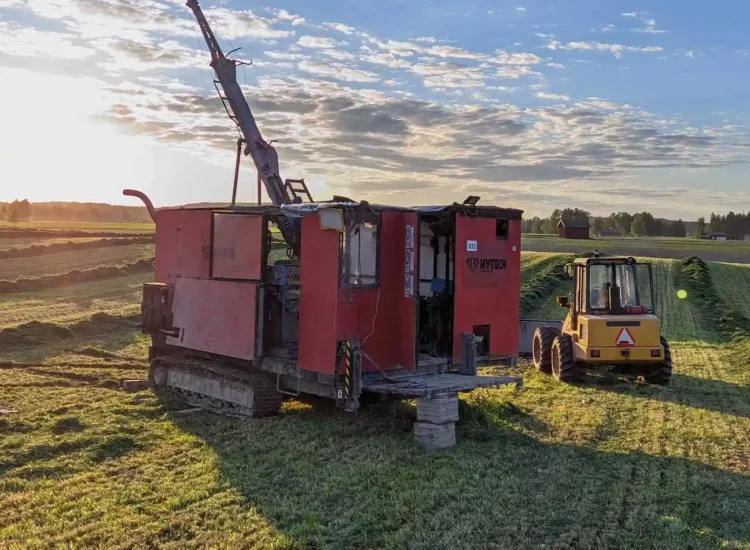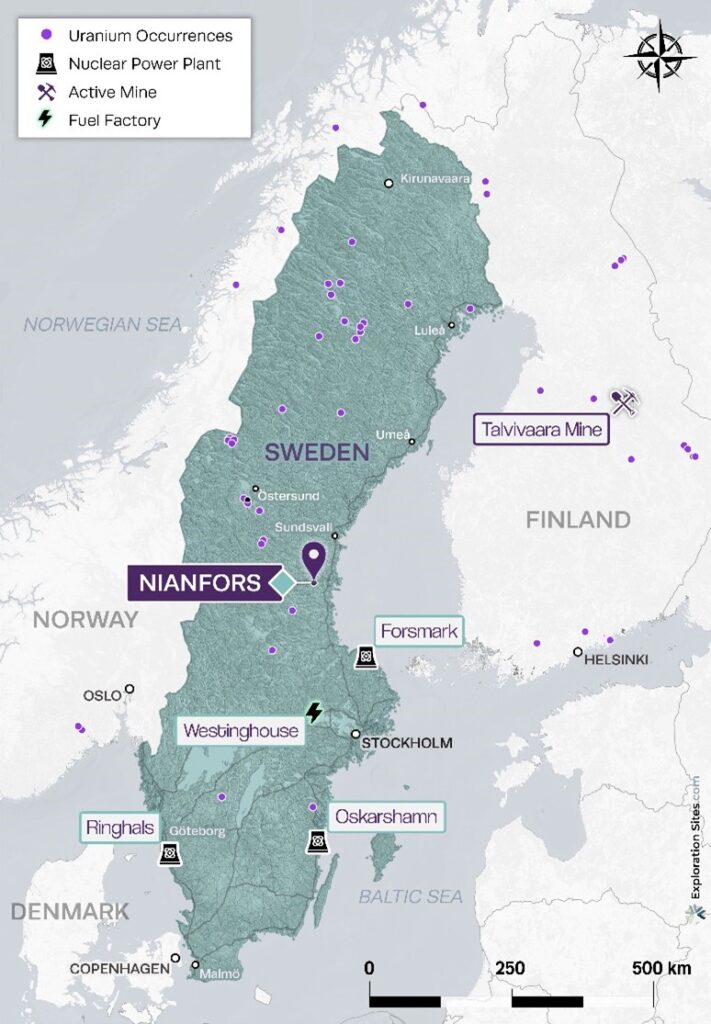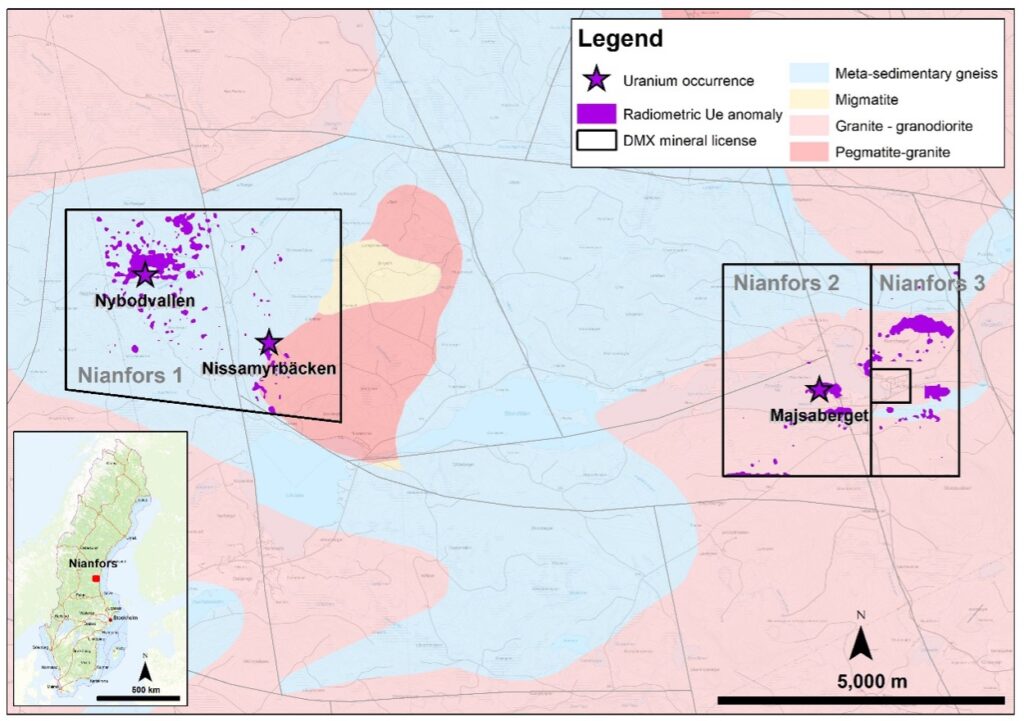
Nianfors – Sweden
Related News
Overview
From June 2023 to November 2025, District Metals received approval from the Bergsstaten (Mining Inspectorate) for the Nianfors nr 1 to 3 mineral license applications to explore for metals and minerals over a 2,135 hectare (ha) area located in the Gävleborgs County in central Sweden (Figures 1 and 2).
Nianfors Property Highlights
- Mineral license Nianfors nr 2 contains the Majsaberget uranium-yttrium-molybdenum occurrence that consists of 889 mineralized boulders over an approximate area of 500 m by 200 m1.
- Assay results from the Majsaberget mineralized boulders returned a weighted average of 0.16% U3O8 and 0.08% Y1. A 1982 report by the Swedish Geological Survey (SGU) reported mineralized boulder assays ranging from 0.01 to 1.4% U3O8, 0.08 to 0.69% Y, 0.05 to 0.22% Mo, and 0.02 to 0.31% Th2.
- The Majsaberget Occurrence was historically estimated to host at least 12,998,896 lbs U3O8 grading 0.07 to 0.14% U3O84. This mineral resource estimate is considered to be a “historical estimate” under NI 43-101 and a qualified person has not done sufficient work to classify the historical estimate as a current mineral resource and District is not treating the historical estimate as a current mineral resource. The potential quantity and grade of the Majsaberget occurrence is conceptual in nature and there has been insufficient exploration to define a mineral resource and it is uncertain if further exploration will result in the target being delineated as a mineral resource. There are no defined methods or parameters used in determining the quantity and grade of the exploration target estimate.
- See Forsberg, L-O., Kullman, F., Lofroth, B., 1985: Description of SKBS Mineral Reserves. Norrland. Uranrapport 1985-3, Sveriges Geologiska AB, IRAP 85026, p. 17 (the “Majsaberget Occurrence Report”).
- The Company views the historical estimate included in the Majsaberget Occurrence Report to be relevant and reliable.
- Total, probable and presumed tonnage of the area: 5,199,558 to 10,399,116 lbs U3O8 (2,358.48 to 4,716.96 tonnes U3O8). In total for the entire area, the potential is estimated to be at least 12,998,896 lbs U3O8 (5,896.2 tonnes U3O8). Mineralization of two types occur in the area. Partly neosome-pegmatite mineralization and partly an impregnation mineralization in gneiss granite. The average content of the former type is estimated to be about 0.06-0.08% U and of the latter type about 0.14% U.
- Mineral resources under the Majsaberget Occurrence Report were classified under previous definition standards and do not match the current categories under NI 43-101.
- The Company is not aware of any more recent estimates or data available to the Company on the Nianfors Uranium Property.
- The Company would need to conduct an exploration program, including twinning of historical drill holes in order to verify the Nianfors Uranium Property historical estimate as a current mineral resource.
- The mineral resource estimates is considered to be a “historical estimate” under NI 43-101 and a qualified person has not done sufficient work to classify the historical estimate as a current mineral resource and District is not treating the historical estimate as a current mineral resource.
- September 2025 results from an Unmanned Aerial Vehicle (“UAV”) radiometric and magnetic survey show a high intensity uraniferous radiometric anomaly located approximately 1.9 km northeast of the Majsaberget occurrence.
- Additional work including geophysical surveys and diamond drilling was highly recommended in a 1984 report by the Swedish Geological Survey (SGU) but was never actually carried out at the Majsaberget occurrence3.
The Company is not treating the Nianfors Uranium Property as a mineral project material to the Company. District has not undertaken any independent investigation of the drill results nor has it independently analyzed the drill results in order to verify the results. District considers these drill results relevant as the Company is using this data as a guide to plan exploration programs. The Company’s current and future exploration work includes verification of the historical data through drilling.
Figure 1: Nianfors Property Location

Geological Setting
The regional geology where Nianfors is situated is part of the Sveckokarelian Province of the Precambrian Baltic Shield which runs from south of Stockholm to the far north of Sweden where Lapponian – Jatulian rocks of Archaean age occur. The Sveckokarelian province is bounded to the west by thrust nappes of sedimentary and volcanic rocks of Caledonian age and its eastern boundary lies across the Baltic Sea in Finland5.
The basement of the Svecokarelian Province developed before and in conjunction with the Svecokarelian orogenesis that occurred ~1,800 to 1,850 million years ago. The basement is dominated by plutonic rocks, usually granitoids, that are ~1,600 to 1,900 million years old, though successive generations of ‘post-orogenic’ or younger granites continued to be intruded until ~1,500 Mya and are found throughout the entire province. The earliest granitoids are believed to be of mantle origin, and have suffered high-grade metamorphism, anatexis and major deformation, whereas the younger granitoids believed to be of crustal origin, are largely unaffected6.
Dolerites are common intrusives occurring as dyke swarms of marking crustal sutures and major fracture zones throughout the area. They are aged ~900 to 1,500 million years ago5.
The supracrustal rocks of the Sveckokarelian Province are composed of Svecofennian terrestrial meta-sediments and metavolcanics dating from ~1,950 to 1,800 million years old. Basal meta-greywackes and meta-argillites predominate in the Svecofennian sedimentary rocks, with rare overlying meta-arenites, meta-arkoses and marbles. The stratigraphically higher metavolcanics are predominantly silicic to intermediate in composition e.g. metarhyolites; while basic metavolcanics occur towards the southeastern part of the province. In many cases, regional metamorphism was of such a high grade that the supracrustals have partly migmatised into gneisses.
Tectonism has commonly caused the supracrustals to become tightly folded, often with multiple generations of folding. Major regional fracture systems, generally trending north to northeastwards, developed during the major D2 deformational event some ~1,820 to 1,870 million years ago7.
The geologic sequence at Nianfors is composed of Proterozoic sedimentary “gneisses” which have undergone upper amphibolite facies metamorphism. The upper, biotite-rich “argillaceous” gneiss overlies a sillimanite bearing “arenitic” gneiss. Part of the meta-argillite associated with mineralization has been skarnified, with the introduction of iron and minor scheelite mineralisation. Other rock types include remnants of basic dykes, granitic dykes and two types of pegmatoid, one of which hosts the mineralisation5.
Figure 2: Nianfors Property Mineral Licenses

Nianfors Exploration History
The Nianfors mineral occurrences were discovered in 1980 during follow-up work of airborne radiometric anomalies by the Swedish Geological Survey (SGU)1. Detailed outcrop mapping, boulder hunting and sampling started in 1981-1982. Over 1,000 radioactive and mineralized boulders and outcrops have been mapped. Three areas of interest were outlined, including Nybodvallen, Nissamybäcken and Majsaberget (Figure 2).
The Nianfors Property and surrounding area is dominated by Proterozoic meta-sedimentary rocks which have experienced upper amphibolite metamorphic grades, forming porphyroblasts of cordierite, sillimanite and garnets. The meta-sedimentary rocks have been intruded by younger uraniferous meta-granite and meta-pegmatites. The two types of mineralization identified include neosome-pegmatite hosted which averages 0.07 to 0.09% U3O8, and impregnation mineralization within meta-sedimentary rocks which averages 0.14% U3O84.
The Majsaberget occurrence appears to be the most prospective and includes 889 mineralized boulders that cover an area of 500 m by 200 m. Assays from the Majsaberget boulder field returned a weighted average of 0.16% U3O8 and 0.08% Y1. A 1982 report by the SGU assayed seven mineralized boulders that returned results ranging from 0.01 to 1.4% U3O8, 0.08 to 0.69% Y, 0.05 to 0.22% Mo, and 0.02 to 0.31% Th2.
Several mineralized outcrops were also found at the Majsaberget occurrence. In the largest of the outcrops, the mineralized zone dips vertically and has a width greater than 4 m where historic assays returned 0.27% U3O8 and 0.1% Y.
Mapping of outcrop at the Majsaberget Occurrence generated a historical exploration target estimated to host at least 12,998,896 lbs U3O8 grading 0.07 to 0.14% U3O84. This mineral resource estimate is considered to be an “historical estimate” under NI 43-101 and a qualified person has not done sufficient work to classify the historical estimate as a current mineral resource and District is not treating the historical estimate as a current mineral resource. The potential quantity and grade of the Majsaberget occurrence is conceptual in nature and there has been insufficient exploration to define a mineral resource and it is uncertain if further exploration will result in the target being delineated as a mineral resource. There are no defined methods or parameters used in determining the quantity and grade of the exploration target estimate.
- See Forsberg, L-O., Kullman, F., Lofroth, B., 1985: Description of SKBS Mineral Reserves. Norrland. Uranrapport 1985-3, Sveriges Geologiska AB, IRAP 85026, p. 17 (the “Majsaberget Occurrence Report”).
- The Company views the historical estimate included in the Majsaberget Occurrence Report to be relevant and reliable.
- Total, probable and presumed tonnage of the area: 5,199,558 to 10,399,116 lbs U3O8 (2,358.48 to 4,716.96 tonnes U3O8). In total for the entire area, the potential is estimated to be at least 12,998,896 lbs U3O8 (5,896.2 tonnes U3O8). Mineralization of two types occur in the area. Partly neosome-pegmatite mineralization and partly an impregnation mineralization in gneiss granite. The average content of the former type is estimated to be about 0.06-0.08% U and of the latter type about 0.14% U.
- Mineral resources under the Majsaberget Occurrence Report were classified under previous definition standards and do not match the current categories under NI 43-101.
- The Company is not aware of any more recent estimates or data available to the Company on the Nianfors Uranium Property.
- The Company would need to conduct an exploration program, including twinning of historical drill holes in order to verify the Nianfors Uranium Property historical estimate as a current mineral resource.
- The mineral resource estimates is considered to be a “historical estimate” under NI 43-101 and a qualified person has not done sufficient work to classify the historical estimate as a current mineral resource and District is not treating the historical estimate as a current mineral resource.
Additional work including geophysical surveys and diamond drilling was highly recommended in a 1984 report by the SGU, but was never conducted at the Majsaberget occurrence3. No exploration work has been conducted on the Nianfors Property for approximately 40 years, and no modern exploration techniques including geophysics and multi-element sampling (including lithium or other REEs) has ever been conducted.
References
2 Forsberg, L-O., 1982: Uranium Prospecting in Norrland. Uranrapport 1982-12, Sveriges Geologiska Undersökning, BRAP 82042, p. 33.
3 Kullman, F., 1984: SKBF:s Detaljprospektering i S. Norrland. Uranrapport 1984-4, Sveriges Geologiska Undersökning, IRAP 84010, p. 52.
4 Forsberg, L-O., Kullman, F., Lofroth, B., 1985: Description of SKBS Mineral Reserves. Norrland. Uranrapport 1985-3, Sveriges Geologiska AB, IRAP 85026, p. 17.
5 Phillips AH, 2005: Revised introductory technical report on eight uranium properties in Northern Sweden; Telluride & Associates for Continental Precious Minerals Inc; revised report 20 Sep 2005; SEDAR filing.
6 Lundqvist T., and Bygghammar, B., 1994 “The Swedish PreCambrian” in Geology : National Atlas of Sweden. Editor Fredén, C.. Royal Swedish Academy of Sciences. First Edition, 208pgs.
7 Weihed, J.B., 2001 Palaeproterozoic deformation zones in the Skellefte and Arvidsjaur areas, northern Sweden. In Weihed J., (Editor) Economic geology Research. Vol. 1, 1999-2000. Uppsala 20001. Sveriges Geologiska Undersökning, C 833, pgs 46 to 68.

